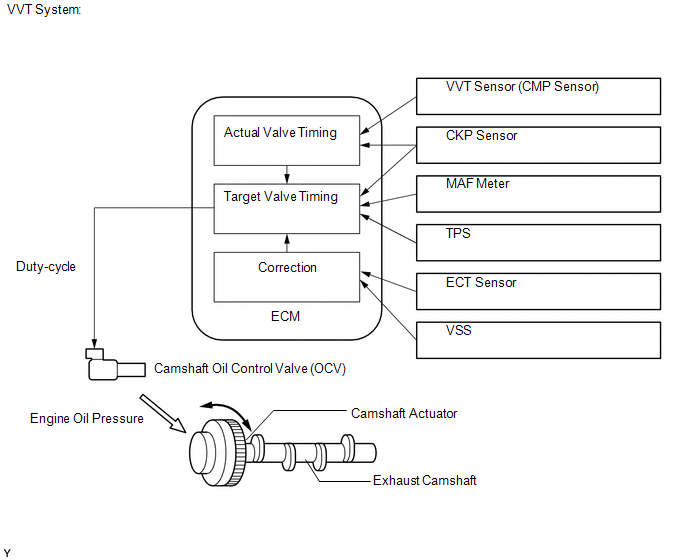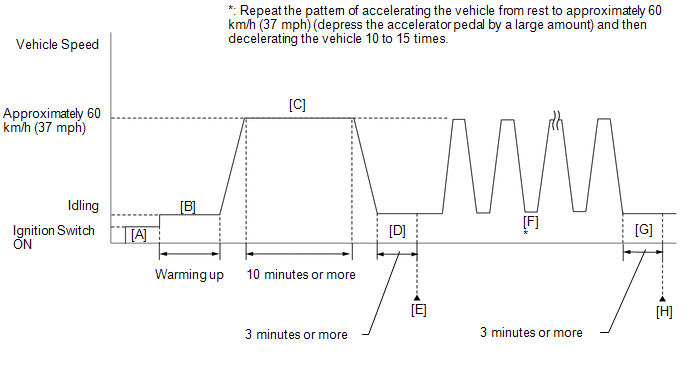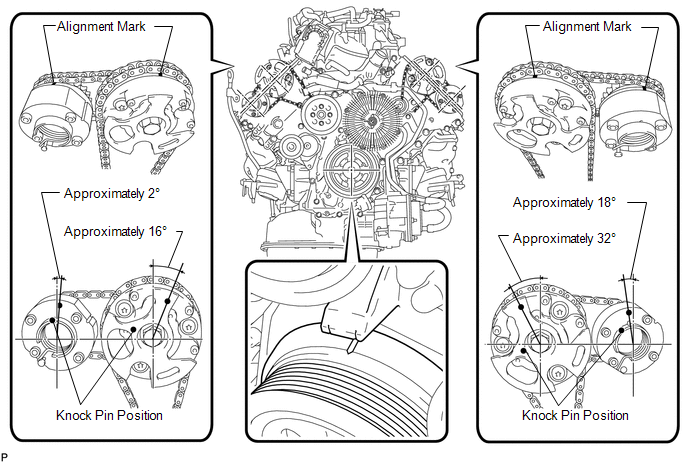DESCRIPTION HINT: If DTC P0014, P0015, P0024 or P0025 is present, check the VVT (Variable Valve Timing) system.
The
Variable Valve Timing (VVT) system includes the ECM, OCV and VVT
controller. The ECM sends a target duty-cycle control signal to the OCV.
This control signal regulates the oil pressure supplied to the VVT
controller. Camshaft timing control is performed according to engine
operating conditions such as the intake air volume, throttle valve
position and engine coolant temperature. The ECM controls the OCV based
on the signals transmitted by several sensors. The VVT controller
regulates the exhaust camshaft angle using oil pressure through the OCV.
As a result, the relative positions of the camshaft and crankshaft are
optimized, the engine torque and fuel economy improve, and the exhaust
emissions decrease under overall driving conditions. The ECM detects the
actual exhaust valve timing using signals from the camshaft and
crankshaft position sensors, and performs feedback control. This is how
the target exhaust valve timing is verified by the ECM.
 |
DTC No. | DTC Detection Condition |
Trouble Area | | P0014
P0024 | Exhaust valve timing is not adjusted in valve timing advance range
(2 trip detection logic) |
- Valve timing
- Oil control valve (OCV) (for exhaust side of bank 1, 2)
- OCV filter
- Camshaft timing exhaust gear assembly
- ECM
| | P0015
P0025 | Exhaust valve timing is not adjusted in valve timing retard range
(1 trip detection logic) |
- Valve timing
- OCV (for exhaust side of bank 1, 2)
- OCV filter
- Camshaft timing exhaust gear assembly
- ECM
| MONITOR DESCRIPTION
- The ECM optimizes the exhaust valve timing using the VVT (Variable Valve
Timing) system to control the exhaust camshaft. The VVT system includes
the ECM, Oil Control Valve (OCV) and VVT controller.
- The ECM sends a target duty-cycle control signal to the OCV. This
control signal regulates the oil pressure supplied to the VVT
controller. The VVT controller can advance or retard the exhaust
camshaft.
If the difference between the target and actual exhaust
valve timing is large, and changes in actual exhaust valve timing are
small, the ECM interprets this as a VVT controller stuck malfunction and
stores a DTC.
- Example:
- A DTC is stored when the following conditions 1 and 2 are met:
- 1. It takes 5 seconds or more to change the valve timing by 5°CA.
- 2. After the above condition 1 is met, the camshaft timing oil control valve is forcibly activated for 10 seconds.
DTCs P0014 and P0024 (Advanced Cam Timing) are subject to 2 trip detection logic.
DTCs P0015 and P0025 (Retarded Cam Timing) are subject to 1 trip detection logic.
These
DTCs indicate that the VVT controller cannot operate properly due to
OCV malfunctions or the presence of foreign objects in the OCV. MONITOR STRATEGY |
Related DTCs | P0014: Advanced camshaft timing (for Bank 1)
P0015: Retarded camshaft timing (for Bank 1) P0024: Advanced camshaft timing (for Bank 2)
P0025: Retarded camshaft timing (for Bank 2) | |
Required sensors/Components (Main) | VVT OCV and VVT Actuator | |
Required sensors/Components (Related) |
Crankshaft position sensor, Camshaft position sensor and Engine coolant temperature sensor | |
Frequency of operation | Continuous | |
Duration | Within 10 seconds | |
MIL operation | Advanced camshaft timing: 2 driving cycles
Retarded camshaft timing: Immediate | |
Sequence of operation | None | TYPICAL ENABLING CONDITIONS |
Monitor runs whenever following DTCs are not present |
P0013, P0023 (Exhaust VVT oil control valve) P0017, P0019 (Exhaust VVT system - Misalignment)
P0102, P0103 (Mass air flow meter) P0107, P0108 (Manifold absolute pressure)
P0115, P0117, P0118 (Engine coolant temperature sensor) P0125 (Insufficient coolant temperature for closed loop fuel control)
P0335 (Crankshaft position sensor) P1340 (Camshaft position sensor) | |
Battery voltage | 11 V or more | |
Engine RPM | 500 to 4000 rpm | |
Engine coolant temperature | 75 to 100°C (167 to 212°F) | TYPICAL MALFUNCTION THRESHOLDS Advanced Camshaft Timing |
Both conditions are met: | - | |
Deviation of actual valve timing and target valve timing |
More
than 5°CA (Crankshaft Angle) for 5 seconds or more after the VVT hold
duty ratio learned value reaches the upper or lower limit. | |
Valve timing | No change at advanced valve timing | Retarded Camshaft Timing |
Both conditions are met: | - | |
Deviation of actual valve timing and target valve timing |
More
than 5°CA (Crankshaft Angle) for 5 seconds or more after the VVT hold
duty ratio learned value reaches the upper or lower limit. | |
Valve timing | No change at retarded valve timing | CONFIRMATION DRIVING PATTERN

- Connect the Techstream to the DLC3.
- Turn the ignition switch to ON and turn the Techstream on.
- Clear the DTCs (even if no DTCs are stored, perform the clear DTC operation).
- Turn the ignition switch off and wait for at least 30 seconds.
- Turn the ignition switch to ON and turn the Techstream on [A].
- Start the engine and warm it up until the ECT reaches 75°C (167°F) or higher [B].
- Drive the vehicle at approximately 60 km/h (37 mph) for 10 minutes or more [C].
CAUTION:
When performing the confirmation driving pattern, obey all speed limits and traffic laws.
- Idle the engine for 3 minutes or more [D].
- Enter the following menus: Powertrain / Engine and ECT / Trouble Codes [E].
- Read the pending DTCs.
HINT:
- If a pending DTC is output, the system is malfunctioning.
- If a pending DTC is not output, perform the following procedure.
- Enter the following menus: Powertrain / Engine and ECT / Utility / All Readiness.
- Input the DTC: P0014, P0015, P0024 or P0025.
- Check the DTC judgment result.
|
Techstream Display |
Description |
|
NORMAL |
- DTC judgment completed
- System normal
|
|
ABNORMAL |
- DTC judgment completed
- System abnormal
|
|
INCOMPLETE |
- DTC judgment not completed
- Perform driving pattern after confirming DTC enabling conditions
|
|
N/A |
- Unable to perform DTC judgment
- Number of DTCs which do not fulfill DTC preconditions has reached ECU memory limit
|
HINT:
- If the judgment result shows NORMAL, the system is normal.
- If the judgment result shows ABNORMAL, the system has a malfunction.
- If the judgment result shows INCOMPLETE or N/A, perform steps [F] through [H].
- Repeat the pattern of accelerating the vehicle from rest to
approximately 60 km/h (37 mph) and then decelerating the vehicle 10 to
15 times [F].
CAUTION:
When performing the confirmation driving pattern, obey all speed limits and traffic laws.
HINT:
Depress the accelerator pedal by a target amount.
- Idle the engine for 3 minutes or more [G].
- Enter the following menus: Powertrain / Engine and ECT / Trouble Codes [H].
- Read the pending DTCs.
HINT:
- If a pending DTC is output, the system is malfunctioning.
- If a pending DTC is not output, perform the following procedure.
- Check the DTC judgment result again.
HINT:
- If the judgment result shows NORMAL, the system is normal.
- If the judgment result shows ABNORMAL, the system has a malfunction.
- If the judgment result shows INCOMPLETE or N/A, perform the following procedure.
- Perform a universal trip and check for permanent DTCs (See page
 ). ).
HINT:
- If a permanent DTC is output, the system is malfunctioning.
- If no permanent DTC is output, the system is normal.
WIRING DIAGRAM Refer to DTC P0013 (See page
 ). ). CAUTION / NOTICE / HINT |
Abnormal Bank | Advanced Timing Over
(Valve Timing Out of Specified Range) |
Retarded Timing Over (Valve Timing Out of Specified Range) | |
Bank 1 | P0014 |
P0015 | | Bank 2 |
P0024 | P0025 |
PROCEDURE |
1. | CHECK ANY OTHER DTCS OUTPUT (IN ADDITION TO DTC P0014, P0015, P0024 OR P0025) |
(a) Connect the Techstream to the DLC3. (b) Turn the ignition switch to ON.
(c) Turn the Techstream on. (d) Enter the following menus: Powertrain / Engine and ECT / Trouble Codes.
(e) Read DTCs. Result |
Result | Proceed to | |
P0014, P0015, P0024 or P0025 |
A | | P0014, P0015, P0024 or P0025 and other DTCs |
B | HINT: If any DTCs other than P0014, P0015, P0024 or P0025 are output, troubleshoot those DTCs first.
| B |
 | GO TO DTC CHART |
|
A |
 | |
| 2. |
PERFORM ACTIVE TEST USING TECHSTREAM (OPERATE OCV) |
(a) Connect the Techstream to the DLC3. (b) Turn the Techstream on.
(c) Warm up the engine. (d)
Enter the following menus: Powertrain / Engine and ECT / Active Test /
Control the VVT Exhaust Linear (Bank1) or Control the VVT Exhaust Linear
(Bank2). (e) Check the engine speed while operating the Oil Control Valve (OCV) using the Techstream.
OK: |
Tester Operation | Specified Condition | |
0% | Normal engine speed | |
100% | Engine idles roughly or stalls |
| NG |
 | GO TO STEP 4 |
|
OK |
 | |
| 3. |
CHECK WHETHER DTC OUTPUT RECURS (DTC P0014, P0015, P0024 OR P0025) |
(a) Connect the Techstream to the DLC3. (b) Turn the Techstream on.
(c) Clear DTCs (See page  ). ). (d) Warm up the engine.
(e) Drive the vehicle in accordance with the driving pattern described in the Confirmation Driving Pattern.
(f) Read the output pending DTCs using the Techstream. OK: No pending DTC output.
| OK |
 | CHECK FOR INTERMITTENT PROBLEMS |
|
NG |
 | |
| 4. |
CHECK VALVE TIMING (CHECK FOR LOOSENESS IN TIMING CHAIN OR JUMPED TOOTH) |
 (a) Remove the cylinder head cover LH and RH.
(b) Turn the crankshaft pulley, and align its groove with the alignment mark "0" of the timing chain cover.
(c)
Check that the alignment marks of the camshaft timing gears and
camshaft timing exhaust gears are at the positions shown in the
illustration.
HINT:
- If the alignment marks are not as shown, turn the crankshaft one revolution clockwise.
- If the result is not as specified, check mechanical parts related to
valve timing for looseness in the timing chain, jumped teeth, etc.
OK: Alignment marks on camshaft timing gears are aligned as shown in the illustration.
| NG |
 | CHECK ENGINE MECHANICAL SYSTEM |
|
OK |
 | |
| 5. |
INSPECT CAMSHAFT OIL CONTROL VALVE ASSEMBLY (OCV) |
| (a) Remove the OCV (See page  ). ). |
|
(b) Measure the resistance according to the value(s) in the table below.
Standard Resistance: |
Tester Connection | Condition |
Specified Condition | |
1 - 2 | 20°C (68°F) |
6.9 to 7.9 Ω | (c) Apply positive (+) battery voltage to terminal 1 and negative (-) battery voltage to terminal 2. Check the valve operation.
OK: Valve moves quickly.
| NG |  |
REPLACE CAMSHAFT OIL CONTROL VALVE ASSEMBLY |
|
OK |
 | |
| 6. |
INSPECT OIL CONTROL VALVE FILTER | (a) Remove the oil control valve filter (See page
 ). ). (b) Check that the filter is not clogged.
OK: Filter is not clogged.
| NG |
 | CLEAN OIL CONTROL VALVE FILTER |
|
OK |
 | |
| 7. |
REPLACE CAMSHAFT TIMING EXHAUST GEAR ASSEMBLY |
(a) Replace the camshaft timing exhaust gear assembly (See page
 ). ). HINT: Perform "Inspection After Repair" after replacing the camshaft timing exhaust gear assembly (See page
 ). ).
|
NEXT |
 | |
| 8. |
CHECK WHETHER DTC OUTPUT RECURS | (a) Connect the Techstream to the DLC3.
(b) Turn the Techstream on. (c) Clear DTCs (See page
 ). ). (d) Warm up the engine. (e) Drive the vehicle in accordance with the driving pattern described in the Confirmation Driving Pattern.
(f) Read the output pending DTCs using the Techstream. OK: No pending DTC output.
HINT: DTC
P0014, P0015, P0024 or P0025 is output when foreign objects in the
engine oil are caught in some parts of the system. These codes will stay
registered even if the system returns to normal after a short time.
These foreign objects are then captured by the oil filter, thus
eliminating the source of the problem.
| OK |
 | END |
| NG |
 | REPLACE ECM | |


